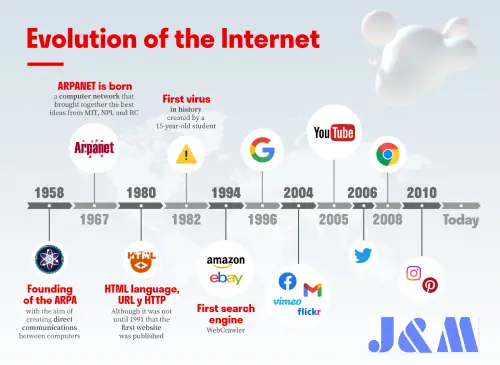

Broadband Communication Technology Solutions
Today’s broadband solutions are highly complex, and semiconductor manufacturers need to integrate a range of innovative technologies to provide system solutions that meet the demands of OEMs, service providers, and users, while keeping power consumption and costs low.
This article provides an overview of various broadband infrastructures, access methods, and home networking technologies, while taking a closer look at the key technology components needed to deliver broadband connectivity between infrastructure and end-user devices.
The Evolution of Broadband Services
Broadband communication encompasses the technologies and equipment necessary to deliver digital voice, video, and data services in packetized form to users. Broadband not only offers users high-speed, always-on internet access, but also enables service providers to offer a variety of value-added services, boosting their revenue. With the rapid growth of the internet, manufacturers are building high-speed communication backbones on a large scale, linking population centers and network service providers' Points of Presence (PoP) worldwide. Backbone infrastructure, or core networks, are mainly built using optical transmission technology.

The last segment of network construction, from homes or small business offices to the backbone infrastructure, is where broadband access technologies come into play, addressing bandwidth limitations. However, these technologies are still in the early stages of deployment. For example, according to a recent study by the Yankee Group, less than 14% of U.S. households with internet access have a broadband connection.
As more households begin using broadband connections, people's lifestyles and work habits have changed. In the past, users who accessed the internet via dial-up modems had to patiently wait for web pages to load. Now, with the shift to broadband internet, they enjoy much faster browsing speeds and many other benefits thanks to significantly higher transmission rates.
For example, faster connection speeds enable a variety of multimedia applications, such as streaming live audio from the internet, displaying or sending digital photos to friends and family, watching news reports and movie trailers, and even exploring hotels, restaurants, and tourist attractions through virtual reality before making reservations.
Additionally, since broadband uses fixed-line technology, users can stay online at any time, unlike traditional dial-up, which required connecting first. As a result, broadband users often keep their computers on and use the internet for daily tasks, like checking TV schedules or looking up phone numbers. In contrast, dial-up was slower and required connecting before any work could begin. Another major advantage of broadband is that it allows users to browse the internet and use their phone at the same time, without needing a second phone line.
Broadband at home also brings the benefit of creating an office-like environment, where users can simultaneously use the phone, connect to high-speed internet, access work emails, share files, and connect to company servers, making remote work easier.
With a home broadband connection, you might also find that if there are multiple computers in the house, you’ll need to share the connection with other family members. This has led many people to install home networks (LANs). Once the network is set up, they often use it to share files or devices like scanners. People can also perform various remote tasks through the internet, such as monitoring their home, checking on kids in daycare, getting real-time traffic updates, or listening to high-quality music through internet radio.
Driving Forces
- Demand for high-speed connections, streaming video, and audio
- Home networks: multiple PCs and connected devices in households
- Personalization: services tailored to individual needs
- Shift from a PC-centric world to a networked device world
- Backbone infrastructure will offer higher transmission capacity (and QoS)
Impacts
- Households and businesses will use more bandwidth
- Infrastructure must provide higher transmission capacity
- End-to-end connections must deliver QoS (Quality of Service)
- Maturity and coexistence of home networking standards
- Voice, video, and audio will be accessible throughout homes and offices
- Network devices, endpoints, and services will be distributed across home networks
- Security mechanisms to protect consumers, providers, and content
- Only TI offers all the building blocks for an end-to-end solution. Since TI supports every system component from end devices to infrastructure, it knows exactly how and where to address end-to-end issues such as security, quality of service, network management, and remote repair capabilities.
- Analog technologies like DSP and digital cordless phones, along with broadband network devices, have driven the growth of mass markets. TI is leveraging its strengths in these markets to enter new product application areas, including networked audio, VoIP, digital cameras, biomedical devices, email terminals, internet terminals, web-enabled TVs, video phones, and other handheld information devices. The internet has become a primary source of information.
- According to IDC’s analysis earlier this year, sales of information appliances (excluding PCs) reached approximately 11 million units, or $2.4 billion, in 1999, and are expected to grow to around 90 million units, or $18 billion, by 2004. While these products will vary greatly, they share key characteristics: ease of use, portability, and high personalization; many will connect via fixed broadband lines.
- TI’s broadband solutions fully leverage the company’s strengths, offering customers highly integrated and innovative solutions that include:
- Leadership in programmable DSP platforms: lowest cost, lowest power consumption, and highest performance
- Leadership in analog technology: power signal conditioning and mixed-signal processing
- Expertise in system, software, and analog integration: world-class system-level integration
- World-class software tools and a DSP value-added network: open systems that help customers reduce time to market and development costs
- Chip/SLI/ASIC technology: custom system solutions for clients
- World-class manufacturing facilities: supporting mass production and fast scaling
- Intellectual property (patents): innovative, warranty-covered technologies
Final Thoughts
We possess all the necessary technology and system knowledge to provide OEMs with complete, innovative solutions from infrastructure devices to end-of-line production equipment.
Subscribe to JMChip Electronics !



















